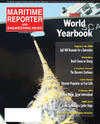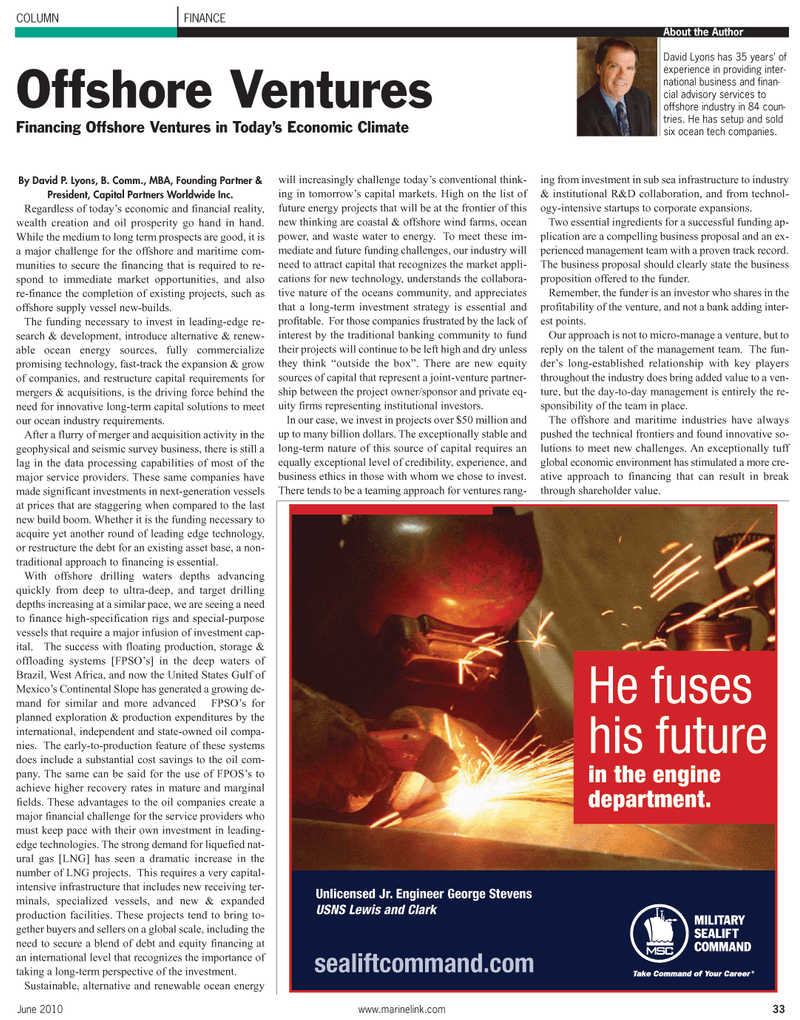
Page 33: of Maritime Reporter Magazine (June 2, 2010)
Read this page in Pdf, Flash or Html5 edition of June 2, 2010 Maritime Reporter Magazine
June 2010 www.marinelink.com 33
By David P. Lyons, B. Comm., MBA, Founding Partner &
President, Capital Partners Worldwide Inc.
Regardless of today’s economic and financial reality, wealth creation and oil prosperity go hand in hand.
While the medium to long term prospects are good, it is a major challenge for the offshore and maritime com- munities to secure the financing that is required to re- spond to immediate market opportunities, and also re-finance the completion of existing projects, such as offshore supply vessel new-builds.
The funding necessary to invest in leading-edge re- search & development, introduce alternative & renew- able ocean energy sources, fully commercialize promising technology, fast-track the expansion & grow of companies, and restructure capital requirements for mergers & acquisitions, is the driving force behind the need for innovative long-term capital solutions to meet our ocean industry requirements.
After a flurry of merger and acquisition activity in the geophysical and seismic survey business, there is still a lag in the data processing capabilities of most of the major service providers. These same companies have made significant investments in next-generation vessels at prices that are staggering when compared to the last new build boom. Whether it is the funding necessary to acquire yet another round of leading edge technology, or restructure the debt for an existing asset base, a non- traditional approach to financing is essential.
With offshore drilling waters depths advancing quickly from deep to ultra-deep, and target drilling depths increasing at a similar pace, we are seeing a need to finance high-specification rigs and special-purpose vessels that require a major infusion of investment cap- ital. The success with floating production, storage & offloading systems [FPSO’s] in the deep waters of
Brazil, West Africa, and now the United States Gulf of
Mexico’s Continental Slope has generated a growing de- mand for similar and more advanced FPSO’s for planned exploration & production expenditures by the international, independent and state-owned oil compa- nies. The early-to-production feature of these systems does include a substantial cost savings to the oil com- pany. The same can be said for the use of FPOS’s to achieve higher recovery rates in mature and marginal fields. These advantages to the oil companies create a major financial challenge for the service providers who must keep pace with their own investment in leading- edge technologies. The strong demand for liquefied nat- ural gas [LNG] has seen a dramatic increase in the number of LNG projects. This requires a very capital- intensive infrastructure that includes new receiving ter- minals, specialized vessels, and new & expanded production facilities. These projects tend to bring to- gether buyers and sellers on a global scale, including the need to secure a blend of debt and equity financing at an international level that recognizes the importance of taking a long-term perspective of the investment.
Sustainable, alternative and renewable ocean energy will increasingly challenge today’s conventional think- ing in tomorrow’s capital markets. High on the list of future energy projects that will be at the frontier of this new thinking are coastal & offshore wind farms, ocean power, and waste water to energy. To meet these im- mediate and future funding challenges, our industry will need to attract capital that recognizes the market appli- cations for new technology, understands the collabora- tive nature of the oceans community, and appreciates that a long-term investment strategy is essential and profitable. For those companies frustrated by the lack of interest by the traditional banking community to fund their projects will continue to be left high and dry unless they think “outside the box”. There are new equity sources of capital that represent a joint-venture partner- ship between the project owner/sponsor and private eq- uity firms representing institutional investors.
In our case, we invest in projects over $50 million and up to many billion dollars. The exceptionally stable and long-term nature of this source of capital requires an equally exceptional level of credibility, experience, and business ethics in those with whom we chose to invest.
There tends to be a teaming approach for ventures rang- ing from investment in sub sea infrastructure to industry & institutional R&D collaboration, and from technol- ogy-intensive startups to corporate expansions.
Two essential ingredients for a successful funding ap- plication are a compelling business proposal and an ex- perienced management team with a proven track record.
The business proposal should clearly state the business proposition offered to the funder.
Remember, the funder is an investor who shares in the profitability of the venture, and not a bank adding inter- est points.
Our approach is not to micro-manage a venture, but to reply on the talent of the management team. The fun- der’s long-established relationship with key players throughout the industry does bring added value to a ven- ture, but the day-to-day management is entirely the re- sponsibility of the team in place.
The offshore and maritime industries have always pushed the technical frontiers and found innovative so- lutions to meet new challenges. An exceptionally tuff global economic environment has stimulated a more cre- ative approach to financing that can result in break through shareholder value.
He fuses his future in the engine department.
Unlicensed Jr. Engineer George Stevens
USNS Lewis and Clark sealiftcommand.com
COLUMN FINANCE
Offshore Ventures
Financing Offshore Ventures in Today’s Economic Climate
About the Author
David Lyons has 35 years’ of experience in providing inter- national business and finan- cial advisory services to offshore industry in 84 coun- tries. He has setup and sold six ocean tech companies.

 32
32

 34
34
